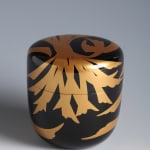-
Artworks
Nishimura Hikobei IX
Tea Caddy with Dried Abalone, 1980sMaki-e gold and silver lacquer on woodSize 3¼ x 3 x 3 in. (8.3 x 7.9 x 7.9 cm)T-4425Further images
-
(View a larger image of thumbnail 1
)

-
(View a larger image of thumbnail 2
)

-
(View a larger image of thumbnail 3
)

-
(View a larger image of thumbnail 4
)

-
(View a larger image of thumbnail 5
)

-
(View a larger image of thumbnail 6
)

-
(View a larger image of thumbnail 7
)

-
(View a larger image of thumbnail 8
)

-
(View a larger image of thumbnail 9
)

-
(View a larger image of thumbnail 10
)

A natsume (container for powdered tea), the turned-wood body finished in polished black roiro lacquer and decorated on the top, sides, and internal risers in gold hiramaki-e (low-relief sprinkled design)...A natsume (container for powdered tea), the turned-wood body finished in polished black roiro lacquer and decorated on the top, sides, and internal risers in gold hiramaki-e (low-relief sprinkled design) with a tied bundle of naganoshi (strips of stretched dried abalone), the interior and risers in silver lacquer. The interior of the lid with the red-lacquer kaō (cursive monogram) of a tea master.
A bundle of strips of dried abalone are used in Japan as an auspicious betrothal gift. So that the design maintains its integrity even when the lid is removed by the tea master during the chanoyu tea ritual, the motifs on the side of the lid are repeated on the inside risers.
The tea caddy comes with its original double fitted tomobako storage boxes, the outside one lacquered and the inside one of kiri-wood inscribed inside its lid Naganoshi natsume (Container for powdered tea with design of stretched dried abalone); the base signed Kyūdai Hikobei (Hikobei IX) with a mark Zōhiko.
Nishimura Hikobei, a Kyoto dynasty of lacquer craftsmen and entrepreneurs, started business in the late seventeenth century. They came to prominence after the Meiji Restoration of 1868 thanks especially to the patronage of the Mitsui, Sumitomo, and other wealthy industrialist families that commissioned their highly decorated and exquisitely crafted lacquered boxes and furniture as gifts both for their own use and, often, as gifts to the Imperial Household.
The family incorporated in 1954 as the Zōhiko Company and the maker of this piece became the ninth Nishimura Hikobei in 1965. As part of a long-term project to nurture the centuries-old tradition of Kyoto lacquerware, he regularly makes replicas of ancient masterpieces and was among those commissioned to create new furnishings for the Ise Grand Shrine, the headquarters of the Shinto religion, whose buildings are rebuilt every two decades, most recently in 2013. -
(View a larger image of thumbnail 1
)









